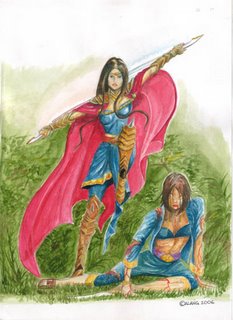Costumes: Anike

Anike, the main character of the play, had two distinct costumes. The first, worn during the initial scene, comrises of a wrap-around top, belt and long skirt. For the following scenes, Anike retained the wrap-around top but the skirt was replaced with calf-length pants and sampin.
Initially, Anike was conceived as a rather timid woman, who became a vengeful soul upon the murder of her brother and the defiling of her brother's corpse. However, as the character and actor developed, I felt that it was more appropriate for Anike to take on a more aggressive stance. And thus, this design for her costume was finalised.
Dark red shades were chosen as the primary colours for Anike's clothing. Red was often a symbol of courage and bloodshed, and was a favoured colour among the ancient Malays. It was chosen to represent Anike's anger and defiance towards King Maniaka.
In contrast to Yasmine's bluish outfit, Anike's represented fire and passion. The gold accessories accentuate the basic elements of the costume to give it some elements of contrast. Gold has also been used to represent wealth, as only the rich could afford such a splendour. This was a statement saying that Anike came from a noble and wealthy family, for only the nobles could wear ornaments of gold. Indicators of wealth were also present in the design of Anike's weapon, a small knife (badik).
The weapon was also a clue to Anike's martial prowess. I felt that it was proper for Anike, being the sister of the great warlord-turned-traitor Sirat, to have some measure of skill in martial arts. Besides, it would be foolish to take on the King's Royal Guards unless one was truly prepared! Another indication of her anticipation of combat were her bracers (arm guards). She wore the arm guards from the first scene, as if she was bracing herself for an unavoidable encounter with the Royal Guards.
In the following scenes, Anike was dressed in pants and sampin, the standard garb of the warrior. The practical reason behind this shift of costume was that Anike needed to be more mobile and flexible for the rest of the play. Symbolically, it represented a shift in Anike's character, from a well-bred lady to that of a seasoned warrior. (Between the lines,) it was also more practical for Anike to be dressed as such in order for her to provide a proper funeral for Sirat's body.



